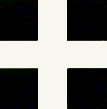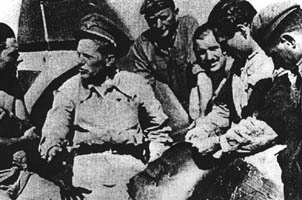Hungary

Örmester Árpád Kertész
Hungary

Örmester Árpád Kertész

Árpád Kertész served in the 1/1. "Íjász" vadászszázad’s (Fighter Squadron) 2. Section operating Fiat CR.32s from Ungvar airfield during the border skirmishes against the Slovaks in the spring of 1939.
On the morning of 24 March 1939, föhadnagy (Lieutenant) Aladár Negró’s 2. Section of the 1/1. vadászszázad was patrolling the area over Szobránc. The section consisted of him, örmester (Sergeant) Sandor Szojak and örmester Kertész. At 07:40 three Slovakian Avia B-534s from 49th letka suddenly appeared.
This was a patrol led by porucík (Lieutenant) Ján Prhácek (commanding officer of the 49th letka) and with desiatnik (Corporal) C. Martiš as no. 2 and LAC Michal Karas as no. 3. They were heading towards Vyšné Remety along the course of the Okna River southwards, where they were to support the attacking troops of the Stakcín group with their operations. The Slovak pilots reported being attacked by Hungarian fighters in the Nižná Rybnica area. Martiš described their surprise attack:
“As soon as I put the fighter to the climbing position shots started flying around me, hitting the aircraft. Turning against the line of fire, I found out that I was attacked by two enemy fighters from the back. I looked at the patrol commander and no. 3 immediately who were attacked by approximately 7-8 enemy fighters and in the east from them there was an enemy bombing aircraft of the type of Caproni in higher altitude. Seeing the situation, I sank to the ground and noticed that my oil tank was shot through and the oil started to leak. The aircraft became impossible. I started to retreat as my last option.”His situation, however, became more serious:
“They followed me by firing and in that moment the rear tell-tale of my cockpit was hit, the shot was warded off but it got to the cockpit cover frame that was deformed.”Martiš realised that he finished fighting with his aircraft and dropped the bombs on fields and locked for the most suitable place for an emergency landing. He picked a meadow in the south from Klokocov, where he landed. He could not find out from altitude that the meadow was soggy and not suitable for landing. This caused the B-534 to sink into mellow ground after 20 meters of landing run and turning over with the pilot sustaining minor injuries. Martiš had been shot down by örmester Szojak, who reported that his victim fell near Lúcky.
Later the same day the whole squadron scrambled at 15:00 hours. They formed in three Vs in the air; fõhadnagy Béla Csekme leading with hadnagy (2nd Lieutenant) V. Gemeinhardt and õrmester M. Tarr as wingmen. Negró’s trio flew on the starboard side and on the port side flew fõhadnagy László Palkó’s 3. Section, with wingmen fõhadnagy Antal Békássy and hadnagy Mátyás Pirity. The CR.32s reached the cloud-base at about 6200 feet and then flew into fog. Soon there was a hole in the clouds and at the same moment Palkó and Pirity noticed three Avia B-534s and three Letov Š.328s on the port side. The 1. Section did not appear to notice the enemy and they flew on and were soon swallowed by the fog. The Avias, which were from 45th letka, jumped Negró’s 2. Section but opened fire too soon, outside the range of their machine-guns. Negró, turned the table and shot down one Avia flown by rotmajster Ján Hergott southeast of Bánovce nad Ondavou. A second Avia, flown by František Hanovec, was shot down by Szojak near Senné.
The Letovs, which were from 12th letka on their way to bomb Hungarian troops at Sobrance, were deserted by their escort and offered a tempting target. They were 300 feet higher thus, in order to gain speed and altitude, Palkó threw his machine into a short dive and then climbed behind the Letovs. He dipped the nose of his CR.32 and sent a burst into the belly of the nearest one. The aircraft caught fire and crashed north of Pavlovce nad Uhom. The pilot slobodník Gustáv Pažický and the observer porucík Ferdinand Švento were both killed. A second Letov was claimed shot down by Pirity. This was a Letov flown by slobodník Jozef Drlicka and his observer podporucík L. Šronk and they made an emergency landing near Strazske.
Three more Avias were discovered and Palkó’s wingmen were now locked in combat with the enemy fighter. Békássy pursued one over the border and emptied a total of a thousand rounds from both machine guns into it before shooting it down. This aircraft was flown by desiatnik Martin Danihel from 45th letka and he made an emergency landing near Brezovice nad Torysa. After having expending all his ammunition Békássy returned to Hungary.
Looking around Pirity saw streams of tracers scorching the sky then noticed an Avia some 1500 feet below. Pirity dived on it but he had to pull out because another CR.32 crossed his path with guns blazing. The sky was now empty, Palkó, staying in the area for a minute or two, sighted Negró’s machine. One by one the other Fiats joined them. Békássy and Szojak had already landed at Ungvar.
The Hungarian pilots totally claimed five Avias and two Letovs in the air combat over Paloc. Negró, Békássy, Szojak, Béla Csekme (not confirmed) and Kertész (one not confirmed over Michalovce) reported the destruction of the Avias, while Palkó and Pirity claimed the Letovs. Gemeinhardt and Tarr had no chance to fire their guns in anger. The Slovakian forces lost three Avia B-534s and two Letovs. Slovakian pilots Hanovec and Danihel both claimed one Fiat but this was not confirmed with the Hungarians.
Porucík Ferdinand Švento, the observer of one of the Letovs, baled out and was wounded in the stomach while descending in his parachute. He fell near a group of Hungarian hussars. Upon impact he forced himself to sit up and reached inside his flying gear. The move was misunderstood and Švento was mortally shot. The hussars found his identification papers in his hand instead of a pistol. Švento was buried with full military honors.
During 1939 he was awarded the Nagy ezüst Vitézségi Érem (Great Silver Medal for Bravery).
He served in the 2/3. “Richie” vadászszázad operating Fiat CR.42s in the summer and autumn of 1941 during the units operations against the Soviet Union.
At around 08:00 on 27 June, the MKHL made its first air attack against Soviet targets, when around 30 bombers comprising Junkers Ju 86s of 4/3. and 4/4. bombázószázad (Bomber Squadron) and one squadron of Caproni Ca.135s of 3/5. bombázószázad attacked targets in Stanislav (now Ivano-Frankovsk). They were escorted by 9 CR 42s of the 2/3. ‘Ricsi’ vadászszázad of the 2./II osztály led by százados vitéz Aladár Szobránczy. After the bombers had done their work, the escorting fighters strafed targets of opportunity in the area. Őrmester (Sergeant) Kertész was lost in dense clouds and when he finally broke through, he sighted a reconnaissance machine. When he flew towards it, it opened fire so he identified it as a Russian reconnaissance aircraft (probably a Polikarpov R-5). After a short exchange of fire, the reconnaissance aircraft burst into flames. He turned back towards his base flying on his instruments but after a while, his fuel ran low and he decided to land. Fortunately, when he landed he found himself among Rumanians. However, it took him more than a week to squeeze some petrol out of them. At last, they gave him some but it was still so little that he had to return to his unit via his pre-war base in Hungary.
During the same mission, the fighter squadron lost CR 42 V.217, when zászlós László Kázár was shot down by antiaircraft fire. He made a forced landing and after setting fire to his personal mount for two years, he managed to return after 16 days spent hiding behind enemy lines, with the help of local Ukrainian anti-Communist guerrillas.
Kertész ended the war with 2 biplane victories.
He passed away in Hungary in 1985.
Claims:
| Kill no. | Date | Time | Number | Type | Result | Plane type | Serial no. | Locality | Unit |
| 1939 | |||||||||
| 24/03/39 | 07:40 | 1 | Avia B-534 (a) | Damaged | Fiat CR.32 | Vyšné Remety area | 1/1. vadászszázad | ||
| 1 | 24/03/39 | 15:00- | 1 | Avia B-534 (b) | Destroyed | Fiat CR.32 | Michalovce | 1/1. vadászszázad | |
| 1941 | |||||||||
| 2 | 27/06/41 | 08:00- | 1 | Russian reconnaissance aircraft (c) | Destroyed | Fiat CR.42 | Stanislav area | 2/3. vadászszázad |
Biplane victories: 2 destroyed, 1 damaged.
TOTAL: 2 destroyed, 1 damaged.
(a) Claimed in combat with 49th letka. Michal Karas’ Avia was undamaged.
(b) Not confirmed. Claimed in combat with 45th letka.
(c) Probably a Polikarpov R-5.
Sources:
Csaba Becze: A magyar királyi 1. honvéd éjjeli vadász repülõszázad Magyar Repüléstörténeti Társaság Konferencia Közleményei 1999 kindly provided by Csaba Becze
Avia B-34, B-534 a Bk-534, slovenských pilotov 1939-1944 – Peter Šumichrast and Jozef And’al, HT model špeciál, ISSN 1335-3667
Biplane Against The Red Bear - Julius R. Gaal, 1974 Air Combat Spring/1974 kindly provided by Santiago Flores
Elfelejtett Hősök - Csaba Becze, 2006 Puedlo Kiadó, ISBN 963-9673-064
Harcok az orosz égen Budapest - László Tomor, 1942 kindly provided by Csaba Becze
“Kőr ász” Egy vadászrepülő század története 1936-1941 - Csaba Becze, 2007 Puedlo Kiadó, ISBN 978-9639673854
Krst ohnom (Plastic Kits Revue) - Juraj Rajninec, 1991 (kindly provided by Ondrej Repka)
One day Air War (Air Combat magazine September/1977) - Julius R.Gaal, 1977 (kindly provided by Santiago Flores)
Slovensti letci/Slovak Airmen 1939-1945 - Jiri Rajlich and Jiri Sehnal, 1991 (kindly provided by Ondrej Repka)
Slovenske letectvo 1939-1944 - Juraj Rajninec, 1997 (kindly provided by Ondrej Repka)
Additional information kindly provided by Dénes Bernád and Csaba Becze.


